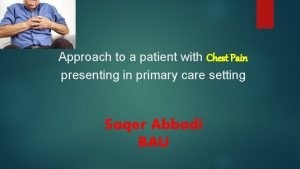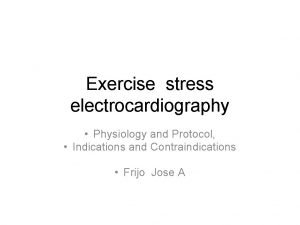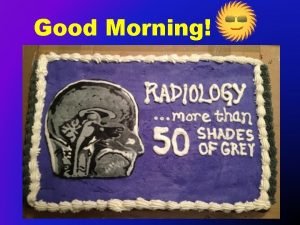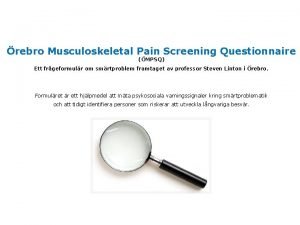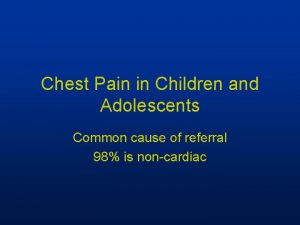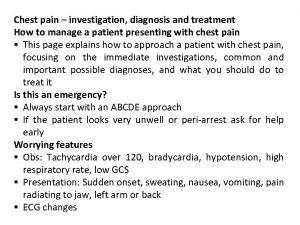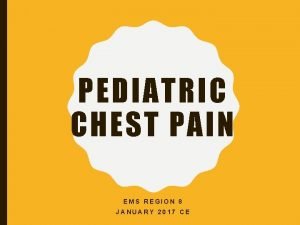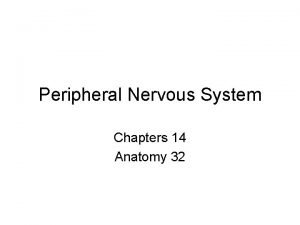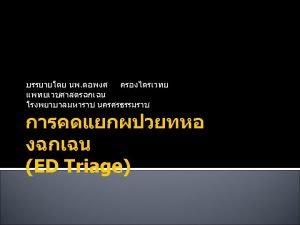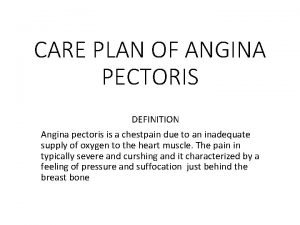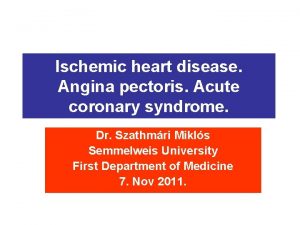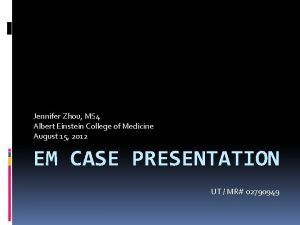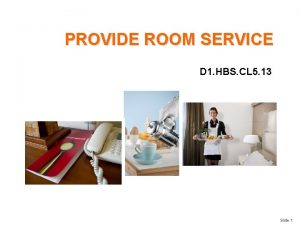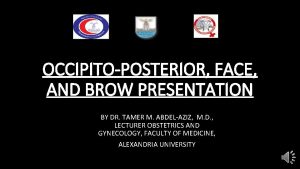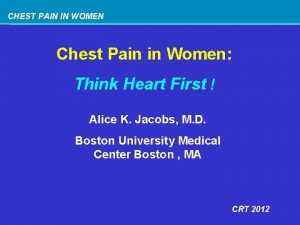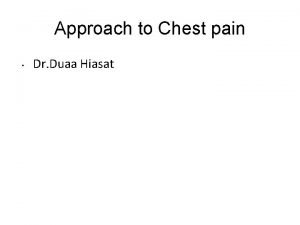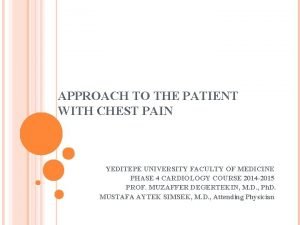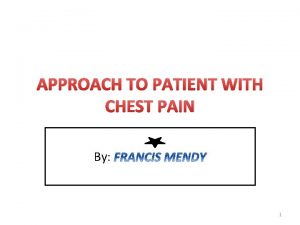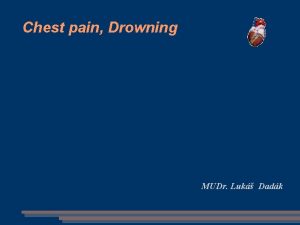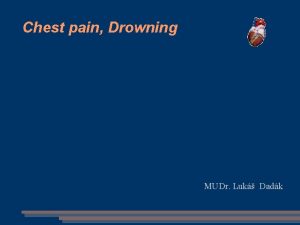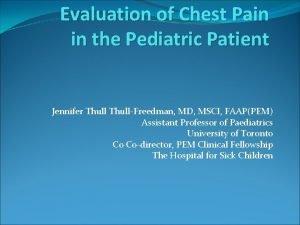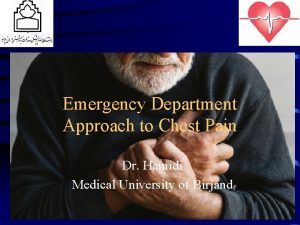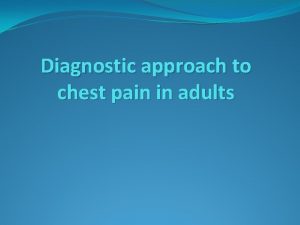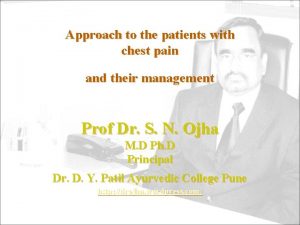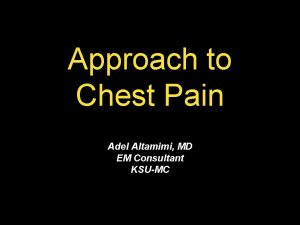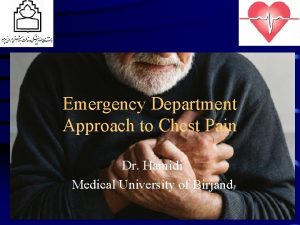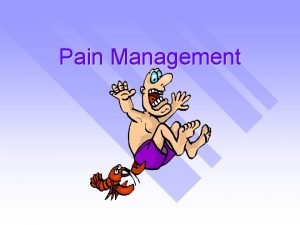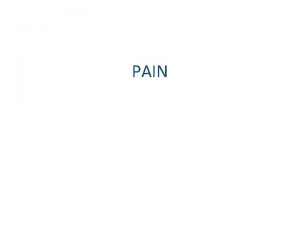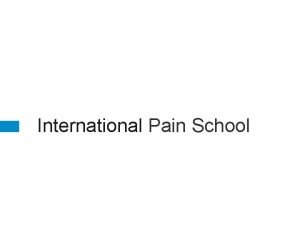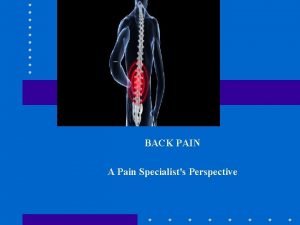Approach to a patient with Chest Pain presenting























- Slides: 23

Approach to a patient with Chest Pain presenting in primary care setting Saqer Abbadi BAU

-Chest pain one of the most common causes of ER visits in Jordan(Ranging from trivial causes to a life-threatning ones) -The most common cause of chest pain? -More than one third of MI patients die before they arrive to the hospital

There is no fail-proof algorithm for approaching chest pain. In general, have a greater index of suspicion for ischemic causes in the elderly, diabetic populations, and those with a history of CAD

Causes: - Cardiogenic - Non-cardiogenic

1. Heart, pericardium, vascular causes a. Stable angina, unstable angina, b. MI c. Pericarditis(pleuritic CP) d. Aortic dissection(Tearing, interscapular) -5 Risk factors in Hx

If pain changes with respiration (pleuritic), changes with body position or if there is tenderness of chest wall, cardiac cause of pain is highly unlikely.

If you suspect a cardiac cause of the pain, sublingual nitroglycerin is appropriate. Also give aspirin if the patient does not have a bleeding disorder. If nitroglycerin relieves the pain, a cardiac cause is more likely.

A common presentation is a patient with chronic stable angina who presents with symptoms suggestive of USA. The following are the initial steps: • Obtain ECG and cardiac enzymes • Give aspirin • Begin IV heparin

2. Pulmonary: Pulmonary embolism (can have pain with pulmonary infarction, Hemoptysis MC sign on ECG? ), pneumothorax, pleuritis (pleural pain), pneumonia, status asthmaticus

3. GI: Gastroesophageal reflux disease (GERD), diffuse esophageal spasm, peptic ulcer disease, esophageal rupture 45 y/o m sever rt. Cp with rash?

4. Chest wall: Costochondritis, muscle strain, rib fracture, herpes zoster, thoracic outlet syndrome 23 y/o heal m co/ sev cp sob swe px tacc tacp sm whi part?

5. Psychiatric: Panic attacks, anxiety, somatization 6. Cocaine use can cause angina or MI.

Approach to a Patient with CP First of all, RESUCITATE (Abc. . ) Hx: a. Character of the pain (pressure, squeezing, tearing, sharp, stabbing, etc. ) b. Location of pain c. Severity of pain

d. Duration of pain e. Setting in which pain occurred (during exertion, at rest, after meal) f. Radiation of pain g. Aggravating or alleviating factors (e. g. , meal, exertion, rest, respiration) h. Does the patient have a cardiac history? Ask about results of previous stress tests, echocardiograms, cardiac catheterization, or of any procedures (PCI or CABG). i. If the patient has a history of angina, ask how this episode differs from previous ones (more severe? longer duration? ).

Physical Examination: Perform a focused physical examination, with attention to cardiopulmonary, abdominal, and musculoskeletal examination.

Tests: a. Obtain ECG in almost all cases(20% missed in 1 st hour) b. Cardiac enzymes (CK, CK-MB, troponin) depending on clinical suspicion(Appear after 3 hours) c. Obtain chest radiograph (CXR) in almost all cases d. Under appropriate clinical setting, work up the patient for pulmonary embolism (PE)

It can be difficult to distinguish between GI causes of chest pain and angina. The decision of whether to initiate a cardiac workup is dependent on a patient’s overall risk of CAD and the clinical presentation.

To summarize: Patient with Chest Pain… 1 - As always, check vital signs. In most cases, obtain a 12 -lead ECG. Compare with an old ECG. Get more information about the patient’s cardiac history and current history of chest pain.

2. Order cardiac enzymes (creatine kinase; creatine kinase-myocardial bound; troponin) × 3, every 8 hours, if unstable angina or MI is suspected.

3. Consider CXR (pneumothorax, widened mediastinum, pleural effusion). Consider ABG or CT scan/V/Q scan if PE is suspected.

4. If myocardial ischemia is suspected: a. Oxygen, 2 L by NC, titrate up as needed b. Nitroglycerin (sublingual) for pain; if pain continues, can give morphine IV c. Keep systolic BP > 90 mm Hg. d. Aspirin

e. Heparin—give a loading dose, then start a drip. Check the PTT in 6 hours. Perform a guaiac stool test before starting heparin. f. Put the patient on a cardiac monitor, and consider transfer to a cardiac care unit.

THANK YOU
 Causes chest pain
Causes chest pain Typical chest pain
Typical chest pain Dmagid
Dmagid Musculoskeletal chest pain
Musculoskeletal chest pain Chest pain in pediatrics
Chest pain in pediatrics Retrosternal chest pain
Retrosternal chest pain Funnel chest
Funnel chest Heart referred pain
Heart referred pain Ctas
Ctas Care plan on angina pectoris
Care plan on angina pectoris Typical chest pain
Typical chest pain Afebrile vss
Afebrile vss Does pregnancy feel like period cramps
Does pregnancy feel like period cramps Is pregnancy pain same as period pain
Is pregnancy pain same as period pain Pain x mad
Pain x mad Patient 2 patient
Patient 2 patient How to set up trays and trolleys
How to set up trays and trolleys Name of presenting organization
Name of presenting organization Organizing qualitative data
Organizing qualitative data Presenting a research proposal
Presenting a research proposal Presenting the product
Presenting the product Occipito-posterior
Occipito-posterior Presenting research findings
Presenting research findings Pengertian report text
Pengertian report text
